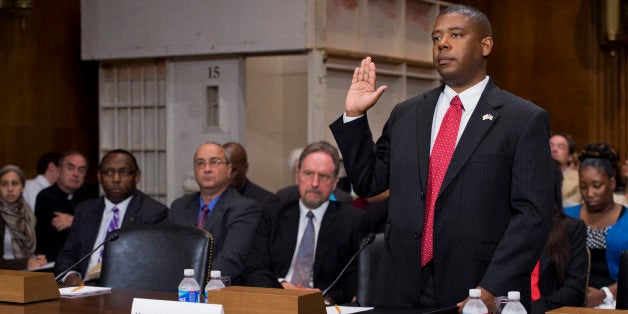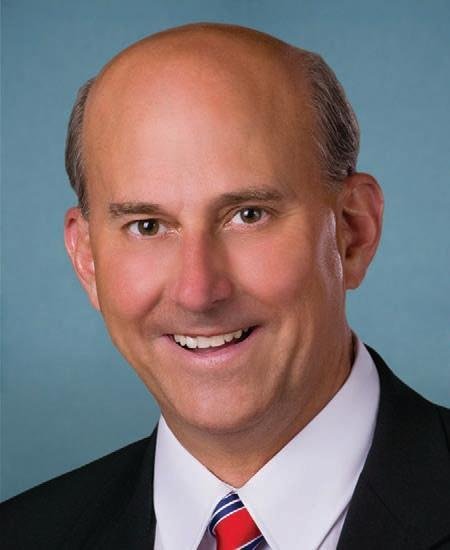Overcrowding in the federal prison system is putting prison workers in danger, said Charles Samuels Jr., director of the Federal Bureau of Prisons, on Wednesday.
“The staff are putting their lives on the line every single day,” said Samuels in his testimony at a Senate Judiciary Committee hearing on challenges facing the federal prison system.
There is one corrections officer for every 150 inmates in the system’s housing units, Samuels noted. To manage this population, the bureau is doubling and tripling the number of inmates bunking cells, and converting television rooms and open bays into sleeping quarters.
Still, “challenges remain as the inmate population continues to increase,” Samuels said.
There are 219,000 inmates in the federal prison system, compared with 25,000 in 1980, according to Bureau of Justice Statistics. Nearly half of these inmates are in prison for drug crimes.
Changing how the government prosecutes those crimes could help reduce overcrowding, Samuels said.
He endorsed U.S. Attorney General Eric Holder’s "Smart on Crime" initiative, which calls for federal prosecutors to consider providing certain non-violent offenders with access to special drug courts and other alternatives to incarceration.
These efforts "will help stem the tide of offenders entering the bureau and lead to lower average sentences where appropriate, and thus should decrease our population somewhat over the long term,” Samuels said.
But some at the hearing expressed reservations about changing sentencing laws for drug offenders.
"It’s hard to think of a more successful domestic policy accomplished over the last 30 years than the reduction of crime rates that we have," said Sen. Chuck Grassley (R-Iowa). "I’m concerned we’re hearing many of the same kinds of voices that headed us towards greater crime starting in the 1960s."
Samuels also emphasized the importance of substance-abuse treatment programs, vocational training programs, and other services aimed at ensuring that prisoners don’t commit new crimes after they’ve been released.
Most inmates “need job skills, vocational training, education, counseling and other assistance,” he said, “if they are to successfully reenter society.
Yet the percentage of inmates with access to these services has declined as the overall prison population has climbed, he noted. Last year, one of the system’s most highly regarded work programs reached only 8 percent of federal inmates, down from 33 percent in 1988.
Not all of Samuels’ recommendations involve reducing the prison population. He also argued that the federal government should begin housing inmates at the Thomson Correctional Center in Illinois, which the government bought in 2012 and remains unused.
The U.S. Department of Justice considered using the former state prison to house Guantanamo detainees as part of the Obama administration's effort to close the military prison facility, before Congress blocked the transfer of Guantanamo detainees to the United States.
Sen. Dick Durbin (D-Ill.) said Wednesday that Thomson prison would provide good-paying jobs for residents of his state, and Samuels said the extra beds were "desperately" needed.
Samuels opened his testimony by saying that he could not continue without acknowledging the loss of two federal corrections officers to violence this year.
In February, Eric Williams, an officer at the United States Penitentiary in Canaan, Pa., was stabbed to death by an inmate while working in a crowded housing unit. Later that month, Lt. Osvaldo Albarati was shot and killed while driving home from a prison in Puerto Rico.
“Their losses further underscore the challenges the dedicated men and women working for the bureau face daily,” Samuels said.
Our 2024 Coverage Needs You
It's Another Trump-Biden Showdown — And We Need Your Help
The Future Of Democracy Is At Stake
Our 2024 Coverage Needs You
Your Loyalty Means The World To Us
As Americans head to the polls in 2024, the very future of our country is at stake. At HuffPost, we believe that a free press is critical to creating well-informed voters. That's why our journalism is free for everyone, even though other newsrooms retreat behind expensive paywalls.
Our journalists will continue to cover the twists and turns during this historic presidential election. With your help, we'll bring you hard-hitting investigations, well-researched analysis and timely takes you can't find elsewhere. Reporting in this current political climate is a responsibility we do not take lightly, and we thank you for your support.
Contribute as little as $2 to keep our news free for all.
Can't afford to donate? Support HuffPost by creating a free account and log in while you read.
The 2024 election is heating up, and women's rights, health care, voting rights, and the very future of democracy are all at stake. Donald Trump will face Joe Biden in the most consequential vote of our time. And HuffPost will be there, covering every twist and turn. America's future hangs in the balance. Would you consider contributing to support our journalism and keep it free for all during this critical season?
HuffPost believes news should be accessible to everyone, regardless of their ability to pay for it. We rely on readers like you to help fund our work. Any contribution you can make — even as little as $2 — goes directly toward supporting the impactful journalism that we will continue to produce this year. Thank you for being part of our story.
Can't afford to donate? Support HuffPost by creating a free account and log in while you read.
It's official: Donald Trump will face Joe Biden this fall in the presidential election. As we face the most consequential presidential election of our time, HuffPost is committed to bringing you up-to-date, accurate news about the 2024 race. While other outlets have retreated behind paywalls, you can trust our news will stay free.
But we can't do it without your help. Reader funding is one of the key ways we support our newsroom. Would you consider making a donation to help fund our news during this critical time? Your contributions are vital to supporting a free press.
Contribute as little as $2 to keep our journalism free and accessible to all.
Can't afford to donate? Support HuffPost by creating a free account and log in while you read.
As Americans head to the polls in 2024, the very future of our country is at stake. At HuffPost, we believe that a free press is critical to creating well-informed voters. That's why our journalism is free for everyone, even though other newsrooms retreat behind expensive paywalls.
Our journalists will continue to cover the twists and turns during this historic presidential election. With your help, we'll bring you hard-hitting investigations, well-researched analysis and timely takes you can't find elsewhere. Reporting in this current political climate is a responsibility we do not take lightly, and we thank you for your support.
Contribute as little as $2 to keep our news free for all.
Can't afford to donate? Support HuffPost by creating a free account and log in while you read.
Dear HuffPost Reader
Thank you for your past contribution to HuffPost. We are sincerely grateful for readers like you who help us ensure that we can keep our journalism free for everyone.
The stakes are high this year, and our 2024 coverage could use continued support. Would you consider becoming a regular HuffPost contributor?
Dear HuffPost Reader
Thank you for your past contribution to HuffPost. We are sincerely grateful for readers like you who help us ensure that we can keep our journalism free for everyone.
The stakes are high this year, and our 2024 coverage could use continued support. If circumstances have changed since you last contributed, we hope you'll consider contributing to HuffPost once more.
Already contributed? Log in to hide these messages.

